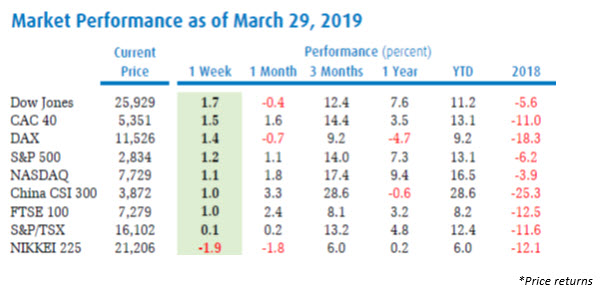Keep connected
Our investment management team is made up of engaged thought leaders. Get their latest commentary and stay informed of their frequent media interviews, all delivered to your inbox.
Jacqueline Ricci
Global stocks had their best first quarter in 20 years as stocks recovered from the massive fourth quarter 2018 decline on lower interest rates and hopes of a 2nd half recovery in 2019. The S&P/TSX Index in Canada gained 13.2% in the first quarter while the S&P500 jumped 14% on strength across the board. While Europe and Japan also showed gains, the developing markets were the biggest winners, with China ahead by 28%, recouping much of their 2018 losses.

Looking back over the past three months, the single most important driver of the surprisingly sharp recovery off the ‘Christmas Eve lows’ was the reversal in the U.S. Federal Reserve from interest rate increases to a ‘wait and see’ approach that emphasized ‘patience’ in looking at the data. The prior expectation of two or three further rate increases in 2019 suddenly switched to a consensus view of no more rate cuts, with a growing belief that the next move would be an interest rate cut.
Helping the bullish case was other global central bankers echoing the U.S. Fed comments. The ECB’s head Mario Draghi could not have been more accommodative in the press conference following the last ECB quarterly meeting. The Bank of Canada also joined the club of ‘dovish central bankers’ with a much more muted view on their economic growth and interest rate prognostications. In a short statement, the Bank of Canada abruptly took an unexpected turn that has the market forecasting a rate cut by the end of this year.
Our investment management team is made up of engaged thought leaders. Get their latest commentary and stay informed of their frequent media interviews, all delivered to your inbox.